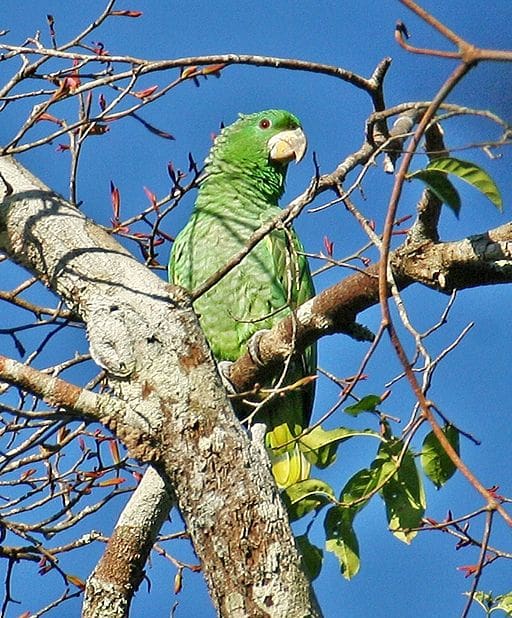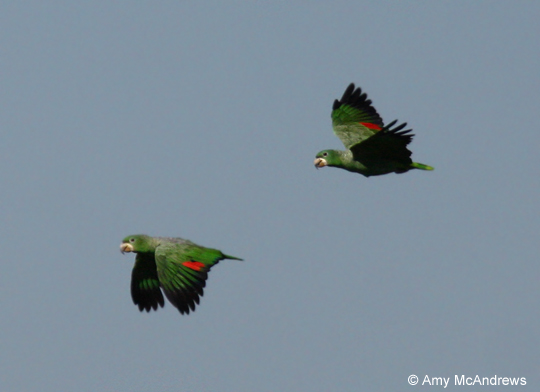White-cheeked Amazon
Also known as:
White-faced Amazon, Kawall's Amazon, White-chinned Amazon
Also known as:
White-faced Amazon, Kawall's Amazon, White-chinned Amazon
DID YOU KNOW?
Amazona kawalli was only recently re-discovered in the wild in 1996, after first being recorded over a hundred years ago.

Amazona

kawalli
Size:
38 cm (14.8 in)
Weight:
Not recorded.
Subspecies including nominate:
one
Colour Adult:
Both adults in general green; black dusting feathers of crown to upper mantle and sides of neck; secondary feathers 1-3 red at bases, the remainder green; yellow/green carpal edge; tail green with broad yellow/green tip, the side tail feathers red at bases bordered with purple/blue, the outermost feathers margined with blue. Beak horn in colouration with dark grey culmen and tip to upper mandible. Buff/white bare skin at base of beak. Eye ring grey. Eye orange/red.
Colour Juvenile:
As in adults.
More Information:
Content Sources:
CITES
Wikipedia
BirdLife International
Cornell Lab of Ornithology/Birds of the World
Parrots: A Guide to Parrots of the World, Juniper and Parr, 1998
Parrots of the World, Forshaw, 2006. 2010 edition
Lexicon of Parrots, Thomas Arndt.
Parrots in Aviculture, Low, 1992.
Captive Status:
Almost unknown in captivity.
Longevity:
At least 10 yrs.
Housing:
Walk-in flight 3 x 1.5 x 2 m (9.8 x 5 x 6.5 ft), outside minimum temperature 15 C (59 F); metal construction necessary.
Diet:
Seed mix of safflower, oats, buckwheat and some sunflower, fruits and vegetables, green leaves, sprouted beans/peas, rosehips, supplements, complete kibble.
Enrichment:
Bird safe wood chew objects (toys, branches), vegetable tanned leather toys; bathing.
Nest Box Size:
—
Clutch Size:
Not recorded.
Fledging Age:
—
Hatch Weight:
—
Peak Weight:
—
Weaning Weight:
—
World Population:
Unknown, described as uncommon. Declining.
IUCN Red List Status:
Least Concern
CITES Listing:
Appendix II
Threat Summary:
Loss of habitat from land cleared for cattle ranching and soy production, facilitated by expansion of the road network. Proposed changes to the Brazilian Forest Code reduce the percentage of land a private landowner is legally required to maintain as forest, further reducing habitat.
Range:
Amazon basin in Brazil, north-west.
Habitat:
Found in tropical rainforest; prefers water’s edge and permanently flooded forest.
Wild Diet:
Seed, palm fruits.
Ecology and Behaviour:
Nests in cavities of trees in flooded areas.
Clutch and Egg Size:
Not recorded.
Breeding Season:
—


![© Jacek Kisielewski [CC BY-SA 3.0] via Wikimedia Commons](https://gt2024.parrots.org/wp-content/uploads/2023/01/wpt_White-cheeked-Amazon_1125-3-100x100.jpg)
